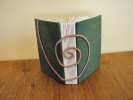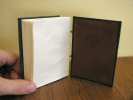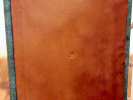

10.7 x 7.7 x 2.5 cm.
Notebook of cream laid paper with deckle edges. Covers in green goatskin with choclolate brown calf blind-tooled doublures. Spiral packed cord sewing in tan thread on leather cord.
This is the first of three "concept" bindings I created shortly after reading Exposed Spine Bindings by Keith Smith. Although this structure is not in Smith's book, many of the techniques for it are.

This book is a variation on packed cord bindings. Most packed cord bindings, however, have sewing supports simply running across the spine. This is nice and easy, because you can use a sewing frame to keep the cords in position while you sew.
Unfortunately, with this binding, I had to hold the cord in place as I sewed, as well as holding the signatures tight enough to compress the folds. For the first turns, this is merely difficult. For later turns, trying to keep the appropriate amount of cord between the stitching (for the curves that go onto the cover), it was nigh on impossible. And I had to get that right, because with packed cord sewing, the thread holds the cord too tight for it to slide about after it's been sewn down.
The entire process was made yet more complicated because I needed to have at least two turns of the cord on the go at once. Packed cord sewing requires this, because you need to travel between the cords within the signatures, to hold them to the support.
When I decided to do this binding, I had a clever, well-planned approach to "checkerboard" the wraps, travelling in an efficient manner between the cords, to minimise the number of times I laid thread into the spine of the book. However, in the prolonged wrestling match with cord, thread, and signatures, with several interruptions from the rest of my life, that clever plan went entirely by the wayside. In the end, I did a lot of quick tacking down with single or double turns of thread, then did all the packing afterward.
This, at least, was easy. I prepared the covers ahead of time, cutting them to the same size as the book block (no squares) and covering them in leather.
After the signatures were stitched, I had a book block with several protruding loops and a long trailing end. I simply positioned the cover on the book block and pulled the cord round and onto the outer cover, then traced the line very lightly in pencil. Then I punched pairs of holes (about 2mm apart) at intervals along the line.
For each loop of cord, I anchored the thread inside the outer signature by tying it to existing stitching. Then I passed it out of the hole in the signature and started packing. Whenever I reached a pair of holes, I would use them to anchor the cord to the cover.


Once I had the cords sewn to the covers, I used some 200 GSM card to fill in the space within the margins of the inside cover (between the leather turn-ins). This covered over, and to a certain extent smoothed over, the lumps of thread between the pairs of holes. Those pairs of holes over the turn-ins left some thread not covered by the cardstock. I pressed them into the leather with a bone folder.
I then cut leather doublures only slightly smaller than the boards themselves, so that they would hide even the inside of the stitching closest to the cover edge. I used glue to stick them down, rather than paste, because I couldn't effectively press the book for long enough for the leather to bond satisfactorily.

Last of all, I blind tooled the evil rooster maker's mark into one leather doublure, and a small spiral into the other.

As noted above, the clever plans I had for sewing the book block onto the cords went entirely by the wayside, and I ended up sewing it every which way. Although this worked, it generated an incredible amount of swell.
Unfortunately, this strikes to the heart of the way that the book was made. I don't think I could get it sewn without a certain amount of to-ing and fro-ing within the signatures. And the alternative, of using paired holes for each extent of the cord, wouldn't be strong enough to hold the paper signatures. They would be prone to tearing out.
I think the only lesson to learn from this is to make this book a one-off. Clever idea, but impractical. My next attempt, the Unsupported Spiral, was a better approach to the problem.